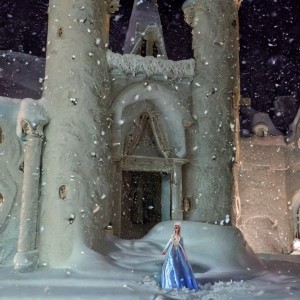History of creation
The fairy tale “The Snow Queen” was written in 1844 and published in the collection “New Fairy Tales” (1845). The collection appeared very successfully on December 21, on the eve of Christmas.
Andersen’s romance with Jenny (Yenny) Lind was in full swing. Although it is difficult to call a romantic relationship a novel: Lind called Andersen a brother. The image of the cold singer, who did not reciprocate with Andersen and 10 years after meeting the married composer, according to biographers, laid the foundation for the image of the Snow Queen. On the other hand, ideal brotherly love is reflected in the image of Gerda. Thus, Gerda and the Snow Queen are two hypostases of the beloved who are not united in one person. These are cold kisses of a heartless beauty or cordial friendship without a hint of erotic relationships.
The mythological basis of the image of the Snow Queen
Andersen was very upset by the death of his father. As a boy, he heard his last words: “Here comes the Ice Maiden, and she came to me.” So in the Scandinavian myths winter, cold and death itself were designated – embodied cold numbness. So the Snow Queen is the personal enemy of Andersen who received a childhood injury.
The philosophical basis of the tale
Andersen was fond of Schelling’s natural philosophy and philosopher J. Boehme. Boehme’s idea of androgynous man was embodied in the opposition of summer and winter. Kai and Gerda are a single whole, they are inseparable in the warm season. But in winter, everyone is confined in his apartment. This is a metaphor for pre-cultural androgynous man. Then the troll’s mirror, a wounding heart and a changing eye is the influence of a culture that separates man from nature. A person does not see the beauty of nature, roses for Kai are ugly, a person enjoys a game of reason – a product of culture. Andersen sees salvation in Christian values.
Literary direction and genre
Andersen is considered a romantic writer. It is a fairy tale – a genre that enjoyed special love in the era of romanticism. For romantics, the ideal is unattainable. The world is filled with opposites; good and evil, life and death, warmth and cold are embodied in different heroes and never mix. But Andersen in his works interweaves reality and fantasy. The magic mirror of the troll is broken, and the fragments penetrate the world of people. Evil enters the world, crowds out good and mixes with it. The heroes of the tale are completely realistic. Yes, the ravens are talking, and the Snow Queen is flying through the sky, but all the characters are vital. So Andersen, obviously, is at a transitional stage from romanticism to realism.
The genre of the fairy tale “The Snow Queen” is often defined as a fairy tale. This is Andersen’s longest tale, it consists of 7 stories, each of them is a certain picture of the world, a stage in a person’s life.
Theme and main idea
The theme of the tale is the same as in all tales: the victory of good over evil, life over death, summer over winter. The main idea is expressed by a wise finca. She explains to the deer that Gerda’s strength is in her “sweet, innocent baby heart.” But Gerda is so strong that people and animals serve her, not by herself. God lives in her heart, it is God who helps a person to overcome evil and makes the weak strongest. So the main idea is consonant with the wisdom of the gospel: love conquers everything.
Following the ancient Greeks, Andersen analyzes and weighs every kind of love. Eros love is embodied in the image of the Snow Queen. Her symbol is a kiss. The snow queen kisses Kai, making his heart become ice. This is a wonderful image: erotic love in itself, without friendship – devilish passion. Strong love, kindred love, is the beginning of good deeds. You can not treat relatives with neglect. And the little robber loves a dissolute mother, so how much does the grandmother deserve love, which Kai mimics! Gerda goes in search of not a friend, not a groom, but a named brother.
Love-fileo, friendship, is the basis of relationships in a fairy tale. All the fabulous heroes helping Gerda become her friends. The image of this love is embodied in the prince and princess. This is an equal relationship. Of all the suitors, only the future prince was not embarrassed and did not grovel in front of the princess. He emphasized that he did not come to get married, but only to listen to the princess’s clever speeches.
The pinnacle of love is the sacrificial love of agape. So Christ loved man, so only God or a man whose heart is filled with God can love. So loved Kaya Gerda.
The motive of sacrifice is closely connected with the image of Gerda. Her first voluntary sacrifice is the new red shoes that she gives to the river to tell her where Kai is. It is interesting that Gerda remains barefoot, despite the fact that the prince and princess give her warm boots. First, they are selected by a little robber, and then he forgets to give a finca. So the sacrifice must be constant.
The fairy tale also presents forms of perverted love. The selfish love of an old woman who knew how to conjure, restrains Gerda, distracts her from her destiny. The robber’s love for his daughter is blind, and such love makes children unbridled and masterful. Both heroines lose the objects of their perverted love: Gerda runs away, and the little robber sets off to travel.
Christian motifs in a fairy tale
In Soviet translations, Christian motifs were thrown out or veiled. Three times in the tale, a psalm is mentioned that Gerda had learned before her misfortune with Kai:
Roses are blooming … Beauty, beauty!
Soon we will see the baby of Christ.
The meaning of this psalm is incomprehensible, because it is translated incorrectly. It seems that a psalm about the joys of life (and roses bloom, and Christmas happens) or about the Second Coming, or that God’s world is beautiful. But in the original, the psalm is not so carefree: “Roses bloom and wither, but soon we will again see Christmas and the baby of Christ.” This is a psalm about the transience of earthly life, about the death that Christ conquered, about the value of eternal life compared to earthly.
For Gerda, this psalm was a consolation. She chose eternal life as a child. And Kai departed from this Christian foundation, he loved mathematics, tricky fun from the evil one. The next time, Gerd sang a psalm in the palace of the Snow Queen, which made Kai get rid of the evil spell. The tale ends with the matured Kai and Gerda understanding the meaning of the psalm. However, the author does not reveal this meaning to the reader.
Among other Christian motifs is the prayer “Our Father”, with the help of which Gerda defeats the army of the Snow Queen and pacifies the winds. She does not win, but legions of angels fight for her.
At the end of the tale, the grandmother reads the Gospel: “If you are not like children, you will not enter the kingdom of heaven.” Actually, the whole fairy tale is a parable about how to be the soul of children.
In Gerda, even an adult remains childish spontaneity and human weakness, for example, a grown-up little robber patronizingly pats her on the cheek. But this, of course, is not the point. In a fairy tale, children’s hearts and souls are contrasted with a cold crafty mind. The last sentence of the tale is a hidden quote from the Bible: “The favorable summer of the Lord will come.” This is a jubilee year when all Jewish slaves were set free. The victory of Kai and Gerda is a symbol of the victory of the slavish nature of man over sin and death. This is the true idea of a children’s fairy tale.
The plot and composition
The first story of the tale plays the role of exposure. This is the myth of the birth of evil. The second story is a parable about how evil entered the human heart. The following 5 stories – the stages of the fight against evil, the trials that lead to the reunification of man with nature, traditions, God and himself, is the restoration of his integrity. The third story is a test of oblivion in the house of an old woman who knew how to conjure, the fourth is a test of wealth in a castle of a prince and a princess, the fifth is a direct danger to life in a castle of robbers, the sixth is a battle with the army of the Snow Queen (a metaphor for the battle of a Christian with demons). The seventh story culminates in a battle with evil in oneself, and this evil is defeated by God’s love. The latest story also contains the denouement. As befits a fairy tale, good conquers evil.
The plot of “The Snow Queen” resembles the plot of a folk fairy tale, reflecting the ancient rite of initiation – the initiation of a child into adulthood. Andersen shows two types of growing up. Gerda grows up through an appeal to traditions, communication and socialization. Kai denies the values of previous generations, but this way does not allow you to become a full member of society. Kai is as lonely as the Snow Queen. He cannot become an adult without help. Only the love of loved ones can help such a teenager.

